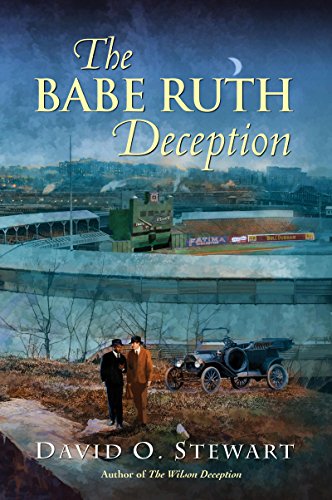The Babe Ruth Deception
- By David O. Stewart
- Kensington Press
- 304 pp.
- Reviewed by Julie Tollefson
- October 10, 2016
A winning tale of prejudice and privilege set in the Roaring Twenties.

In the fall, baseball fans’ emotions soar or sink in rhythm with the fortunes of their favorite teams. The nail-biting suspense of no-hitters. The elation of a late-inning game-winning grand slam. The perfect double play. Fans live for moments like these. David O. Stewart’s new novel, The Babe Ruth Deception, captures that passion as the foundation of a compelling tale populated by mobsters, bootleggers, and one of the greatest players of all time.
The novel reunites Jamie Fraser and Speed Cook, sometimes-friends who have joined twice in the past to help each other out of difficult situations. Baseball brings them together in this story, set in 1920-1921, when accusations of cheating in the 1919 World Series by the Chicago White Sox taint the game.
Questions arise about Babe Ruth’s win in the 1918 series, threatening not just Ruth’s already legendary status but even the future of the game. Ruth enlists Cook, a black promoter for Negro baseball who played professionally before the game was segregated, to help keep his name clear. Cook, in turn, seeks assistance from Fraser, a white doctor whose wife is involved in producing a movie starring Ruth.
Though Babe Ruth stars in the book’s title role and baseball is the backdrop against which the story plays out, the emotional heart of the novel lies in the relationship between Cook’s son Joshua and Fraser’s daughter Violet, a black man and a white woman who fall in love despite society’s censure.
From early in the story, we see trouble ahead for Joshua, a young man struggling to find his way in the aftermath of his service during World War I. When he runs toward danger and saves Violet’s life, we cheer for him. When his big dreams lead him toward greater danger, we wish we could reach into the pages of the book and prevent his impulsive recklessness. Any parent of a teenager knows this feeling well.
The Babe Ruth Deception raises questions of racism, prejudice, and privilege that, appropriately, are not entirely put to rest. Though these issues thread throughout the book, depicted in the stark inequalities between white characters and characters of color, they are most fully presented in the love story of Joshua and Violet and their parents’ reaction.
Violet’s parents, Jamie and Eliza, come across as a bit shallow in their opposition to their daughter’s new love. Their concern lies solely in what the future holds for her. “The world isn’t ready for this sort of thing,” Jamie Fraser says. “It can only end terribly.” Yet he professes color doesn’t matter.
Speed Cook also opposes the relationship, but his fears are different, deeper. His son’s very life is at stake. “Don’t you understand son?” he asks. “They’ll kill you and they’ll feel good about it.” Unlike the Frasers, his worries extend beyond his son to Violet as well. “Have you explained it to her?” he asks Joshua. “Because she can’t really know it, not with who she is and where she’s from. Did you ask her if she wants to be a widow?”
It’s exchanges like this that make Speed the most sympathetic and compelling character, a welcome relief when the actions and thoughts of so many characters center only on their own affairs.
Any resolution to issues of race and racism within the book’s pages is uneasy at best, as seen most clearly in intimate moments between Joshua and Violet. When Joshua uses a racist term in reflecting on their situation, Violet says “I don’t like it when you talk like that.” His response speaks volumes for times both past and present: “Us not saying the words won’t stop them from saying them, from thinking them.”
The language, in fact, makes for uncomfortable reading. Though the frequent use of racial and ethnic slurs may be historically accurate, they grate on modern ears and interfere with the flow of the story.
Aside from that, Stewart’s prose and eye for detail lead to nice turns of phrase and observations (“He exhaled his first puff, the one that felt best and you paid most attention to”) that root the reader deeper in the story. Characters share a box of Cracker Jacks as they lament the Black Sox scandal of the past year. “When fans have to cough up two bits for a seat at the ballpark,” one says, “the least the players can do is actually try to win the game.”
And even those who’ve never caught a ball can feel the pain his beloved game inflicted on Speed Cook in this passage: “Most of his fingers got broken one time or another. Also, some bones in his hands. By the end of a game catching fastballs, curves, spitters, shine balls, whatever the hell the pitcher was dishing up, his hands swelled up to twice normal size.”
The Babe Ruth Deception is a solid story of friendship, love, and baseball set at a turning point in American history. It offers a glimpse of some of the worst of human nature — scandal, greed, racial tension — yet leaves the reader rooting for the home team.
[Editor’s note: David O. Stewart is president of the Washington Independent Review of Books.]
Julie Tollefson is a writer and editor whose short fiction has appeared in Alfred Hitchcock Mystery Magazine, Flash and Bang: A Short Mystery Fiction Society Anthology, and Fish Nets: The Second Guppy Anthology.

